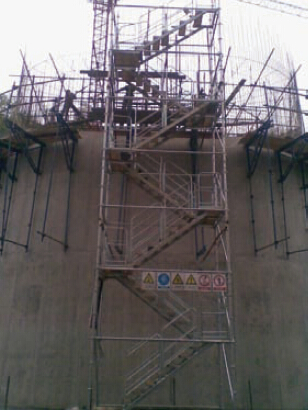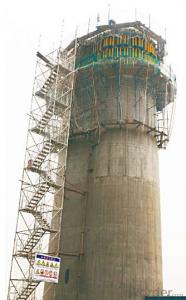Stair-Tower for Formwork and Scaffolding system
- Loading Port:
- Tianjin
- Payment Terms:
- TT OR LC
- Min Order Qty:
- 50 m²
- Supply Capability:
- 1000 m²/month
OKorder Service Pledge
Quality Product, Order Online Tracking, Timely Delivery
OKorder Financial Service
Credit Rating, Credit Services, Credit Purchasing
You Might Also Like
Stair Tower
The structure of ring-lock stair tower is the same as Φ60 ring lock scaffolding.
The dimension of cross section is 1500×3000mm.It is widely used in construction.
Bearing Capacity of Stair Tower:
The stair tower can be erected with the maximum height of 150m,
when attached to the wall every 4.5m.


- Q:Can steel formwork be used for heritage restoration projects?
- Yes, steel formwork can be used for heritage restoration projects. Steel formwork offers several advantages that make it suitable for such projects. Firstly, steel formwork is highly durable and can withstand the rigors of restoration work. It can be reused multiple times, making it a cost-effective option in the long run. Additionally, steel formwork provides excellent stability and structural integrity, ensuring that the restored heritage structure is sturdy and safe. Moreover, steel formwork allows for precise shaping and detailing, which is crucial in restoring heritage buildings to their original design and aesthetics. Lastly, steel formwork can be easily customized to match the unique requirements of each restoration project. Overall, steel formwork is a reliable and efficient choice for heritage restoration projects.
- Q:What are the different types of formwork joints used in steel formwork?
- Steel formwork utilizes various formwork joints to ensure proper alignment, stability, and strength. Some common types of formwork joints in steel formwork are as follows: 1. Butt Joint: The most frequently used joint in steel formwork is the butt joint. This joint involves aligning two formwork panels end-to-end, with direct contact between their edges. Bolts or clamps are then used to secure the panels tightly. 2. Lap Joint: In a lap joint, one formwork panel overlaps another, creating a connection between the two panels. This joint adds strength and stability to the formwork system. Typically, bolts or clamps secure the overlapping section. 3. Corner Joint: A corner joint connects two formwork panels at a corner. This joint is typically achieved by cutting and welding the panels at a 90-degree angle. The welded joint ensures a strong and secure connection. 4. T-Joint: A T-joint occurs when one formwork panel intersects another panel at a right angle, forming a "T" shape. This joint is commonly used in complex formwork systems requiring multiple panel connections. 5. Hinged Joint: A hinged joint is used when a flexible connection is necessary between two formwork panels. This joint allows for movement and adjustment of the panels, accommodating irregular shapes or angles in the formwork. 6. Slip Joint: A slip joint creates a temporary and adjustable connection between two formwork panels. This joint facilitates easy removal and repositioning of the panels during construction. It is often employed when formwork needs adjustment for different pour heights or angles. These examples represent only a few of the formwork joints available for steel formwork. The specific joint chosen depends on project requirements, including load-bearing capacity, ease of assembly and disassembly, and overall stability of the formwork system.
- Q:Are there any limitations or disadvantages of using steel formwork?
- Yes, there are some limitations and disadvantages of using steel formwork. One limitation is the cost. Steel formwork is generally more expensive than other types of formwork, such as wood or aluminum. This can make it a less viable option for projects with tight budgets. Another limitation is the weight and bulkiness of steel formwork. It can be difficult to transport and handle due to its heavy weight, which may require additional equipment and labor. Additionally, the bulkiness can make it challenging to store and stack the formwork when not in use. Steel formwork also requires skilled labor for assembly and disassembly. Unlike other types of formwork, such as modular or reusable plastic formwork, steel formwork often needs to be custom-made and fitted on-site. This can increase labor costs and time required for the construction process. Furthermore, steel formwork is susceptible to corrosion if not properly maintained. Exposure to moisture, chemicals, and harsh weather conditions can lead to rusting, weakening the formwork over time. Regular inspections and maintenance are necessary to ensure the longevity and safety of steel formwork. Lastly, steel formwork may not be suitable for all types of construction projects. Its rigidity and lack of flexibility make it less adaptable to complex or irregular shapes. In such cases, other formwork materials or systems might be more suitable. Despite these limitations and disadvantages, steel formwork also offers several advantages, such as durability, reusability, and high load-bearing capacity. Therefore, it is essential to carefully consider the specific requirements of the project before deciding whether to use steel formwork.
- Q:How does steel formwork affect the overall construction timeline?
- Steel formwork can significantly impact the overall construction timeline by expediting the process. Its durability and reusability allow for faster assembly and dismantling, reducing the time required for formwork installation and removal. Additionally, steel formwork provides a smoother surface finish, minimizing the need for additional plastering or rendering work, further saving time during the construction phase.
- Q:What are the different types of formwork bracing used in steel formwork?
- There are several types of formwork bracing used in steel formwork, including diagonal braces, horizontal braces, vertical braces, and cross braces. These bracing elements are essential for providing stability and support to the formwork system, ensuring the safe construction of concrete structures.
- Q:Can steel formwork be used for curved or irregular structures?
- Yes, steel formwork can be used for curved or irregular structures. Steel formwork is highly flexible and can be easily shaped or modified to accommodate various curves and irregular shapes. It offers excellent strength and durability, making it suitable for complex structures that require precise and customized formwork solutions.
- Q:Can steel formwork be easily disassembled and removed after construction?
- Yes, steel formwork can be easily disassembled and removed after construction. Steel formwork systems are designed to be reusable and have a high level of flexibility in terms of assembly and disassembly. The components of steel formwork are typically lightweight and can be easily handled and moved by construction workers. Additionally, steel formwork systems often utilize adjustable clamps and brackets, allowing for quick and efficient disassembly. The ease of disassembly and removal of steel formwork not only saves time and labor costs but also allows for the formwork to be reused in future construction projects, making it a sustainable and cost-effective choice for construction projects.
- Q:How does steel formwork contribute to the accuracy of concrete placements?
- Steel formwork contributes to the accuracy of concrete placements in several ways. First and foremost, steel formwork is known for its high level of dimensional accuracy. This means that the steel panels and components used in the formwork system are manufactured with precise measurements and tolerances, ensuring that the concrete structures being formed will have the correct dimensions and shape. Additionally, steel formwork provides excellent stability and rigidity, which prevents any movement or deformation during the concrete pouring and curing process. This stability is crucial in maintaining the accuracy of the concrete placement, as any shifting or warping of the formwork can lead to inconsistencies in the final product. Moreover, steel formwork is highly durable and can withstand the pressure exerted by the fresh concrete. This durability ensures that the formwork remains intact and maintains its shape throughout the entire placement process. It also eliminates the risk of bulging or sagging, which can compromise the accuracy of the concrete placement. Furthermore, steel formwork allows for precise control of the concrete's surface finish. With steel formwork, the concrete can be easily molded and shaped to achieve the desired surface texture and quality. This is particularly important in architectural applications where aesthetics play a significant role. Lastly, steel formwork is reusable and can be easily assembled and disassembled, allowing for multiple uses. This reusability factor contributes to cost-effectiveness and also ensures that the formwork remains in optimal condition for accurate concrete placements over time. Overall, steel formwork's dimensional accuracy, stability, durability, surface finish control, and reusability make it a valuable tool in achieving accurate and high-quality concrete placements.
- Q:Can steel formwork be used for water-retaining structures?
- Yes, steel formwork can be used for water-retaining structures. Steel formwork provides a strong and durable solution for constructing such structures due to its ability to withstand the pressure exerted by the retained water. Additionally, steel formwork can be easily sealed and waterproofed to ensure a watertight construction.
- Q:How does steel formwork handle concrete pump pressure?
- Steel formwork is highly durable and strong, allowing it to effectively handle concrete pump pressure. Its robust structure and rigidity help distribute and withstand the force exerted by the concrete pump, ensuring that the formwork maintains its shape and integrity during the pouring process. This enables the steel formwork to effectively contain and support the concrete, resulting in a successfully executed construction project.
1. Manufacturer Overview |
|
|---|---|
| Location | |
| Year Established | |
| Annual Output Value | |
| Main Markets | |
| Company Certifications | |
2. Manufacturer Certificates |
|
|---|---|
| a) Certification Name | |
| Range | |
| Reference | |
| Validity Period | |
3. Manufacturer Capability |
|
|---|---|
| a)Trade Capacity | |
| Nearest Port | |
| Export Percentage | |
| No.of Employees in Trade Department | |
| Language Spoken: | |
| b)Factory Information | |
| Factory Size: | |
| No. of Production Lines | |
| Contract Manufacturing | |
| Product Price Range | |
Send your message to us
Stair-Tower for Formwork and Scaffolding system
- Loading Port:
- Tianjin
- Payment Terms:
- TT OR LC
- Min Order Qty:
- 50 m²
- Supply Capability:
- 1000 m²/month
OKorder Service Pledge
Quality Product, Order Online Tracking, Timely Delivery
OKorder Financial Service
Credit Rating, Credit Services, Credit Purchasing
Similar products
New products
Hot products
Hot Searches
Related keywords
























